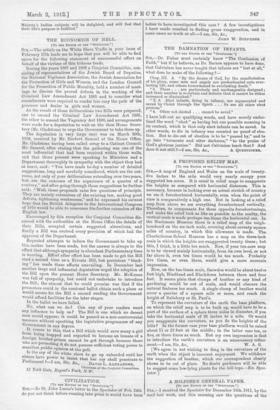A PROPOSED RELIEF MAP. [To VIP EDITOR OP TIER "
srscriros.."]
Sin,—A map of England and Wales on the scale of twenty- five inches to the mile would very nearly occupy your suggested ten acres. It is usual in relief maps to exaggerate the heights as compared with horizontal distances. This is necessary, because in looking over an actual stretch of country we see it foreshortened horizontally, even when the point of view is comparatively a high one. But in looking at a relief map from above we see everything foreshortened vertically. Therefore, to compensate for these opposite foreshortening% and make the relief look as like as possible to the reality, the vertical scale is made perhaps ten times the horizontal one. In the Haslemere Museum there is a relief map of the neigh- bourhood on the six-inch scale, covering about seventy square miles of country, in which this allowance is made. The Charterhouse School Museum has a map on the three-inch scale in which the heights are exaggerated twenty times ; but this, I think, is a little too much. Now, if your ten-acre map is to be viewed mainly horizontally, from its own level, or not far above it, even ten times would be too much. Probably five times, or even three, would give a more accurate impression.
Now, on the ten-times scale, Snowdon would be about twelve feet high, Hindhead and Blackdown between three and four feet. It seems plain that clumps of heather or any kind of gardening would be out of scale, and would obscure the natural features too much. A single clump of heather would cover a quarter of a square mile or more, and reach the height of Salisbury or St. Paul's.
To represent the curvature of the earth the base platform, on which the relief map is to be built up, would have to be a part of the surface of a sphere three miles in diameter, if you take the horizontal scale of 25 inches to a mile. Or would you exaggerate the curvature, as you do the heights of the hills ? In the former case your base platform would be raised about 11 or 12 feet at the middle ; in the latter case ten, or five, or three times as much. But my own impression is that to introduce the earth's curvature is an unnecessary refine-
We agree in not wishing to drag in the curvature of the earth when the object is innocent enjoyment. We withdraw the suggestion of heather, which our correspondent clearly shows to be out of place. No doubt gardeners will be able to suggest some low-lying plants for the hill-tops.—ED. Spec- tator.]










































 Previous page
Previous page